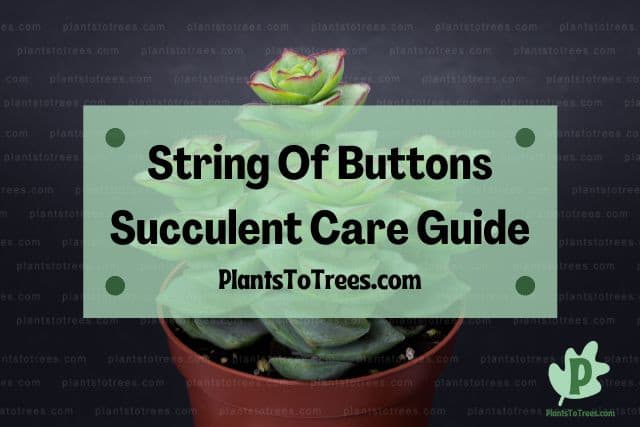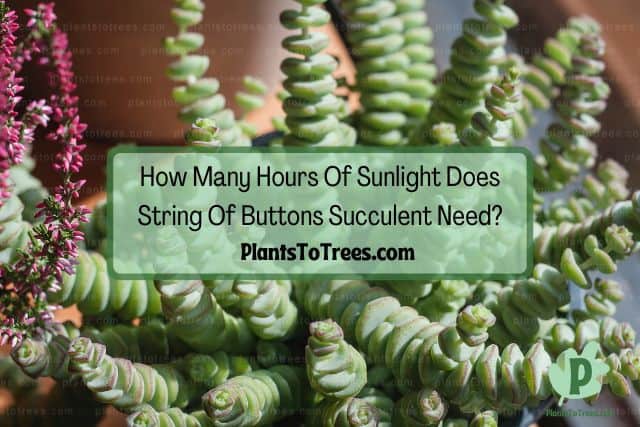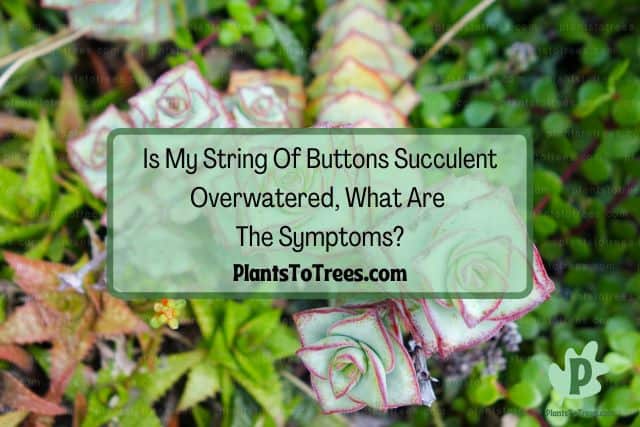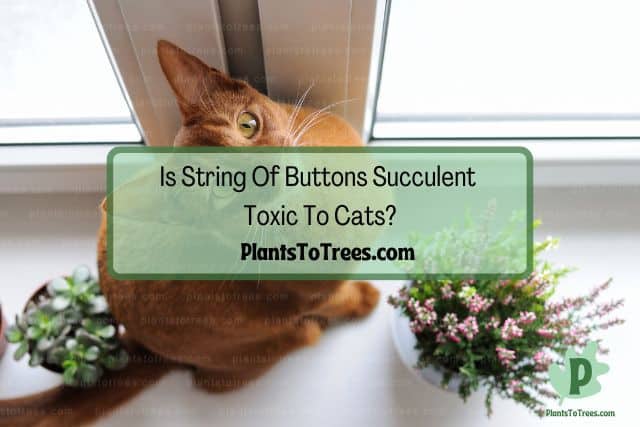String of buttons succulent is an easy going plant grown for its interesting foliage that resembles buttons packed tightly together on a string. If you’re new to the whole gardening scene or you just want to grow a low maintenance plant, give the string of buttons succulent a look.

With a string of buttons succulent care guide, you will learn all that is required to care for this plant, including its temperature tolerance, the type of soil it needs, how many hours of sunlight you should provide it, and how often to fertilize the plant.
Other Names Of String Of Buttons Succulent
Most plants have more than one name that they go by. In most cases, these names can vary from one region to the next.
String of buttons succulent is known by several other names, including stacked crassula, pagoda plant, and necklace vine. The scientific name for the string of buttons is Crassula perforata and this plant produces thick triangle-shaped leaves that are packed around its upright stems.
Frost Tolerance And USDA Hardiness Zones Of String Of Buttons Succulent
Most gardeners check the frost tolerance and hardiness zones of a plant before they decide to take on the task of growing it. Knowing this information is one of the first steps in ensuring you can properly care for the succulent.
String of buttons cannot tolerate cold or frost. It is hardy in USDA hardiness zones 9 to 11, which means most gardeners will have to grow this plant inside. With that said, however, you can still bring the succulent outdoors when the temperatures are above 65 degrees.
How Many Hours Of Sunlight Does String Of Buttons Succulent Need?

Some plants need an abundance of sunlight, while others only need a few hours. But how may hours of sunlight does the string of buttons succulent need?
The string of buttons succulent needs about six hours of sun every day. They do well as a houseplant in any hardiness zone as long as they get this amount of light. Without the ideal lighting requirements, the health and overall look of your succulent will suffer.
String Of Buttons Succulent Needs Direct Or Indirect Sunlight?
Sunlight is a vital part of a plant’s life, and not giving the string of buttons succulent the right type of light can be detrimental to its health.
String of buttons succulent needs six hours of direct sunlight a day. Alternatively, place them in indirect light as long as they receive the indirect sun for the entire day. This plant has a rosy pink color at its leaf edges, and this color becomes more intense if you increase its sun exposure.
Is String Of Buttons Succulent An Indoor Plant, Outdoor Plant Or Both?
Not all plants can safely grow outdoors in every climate. That is why it is important to check whether or not the string of buttons succulent can grow indoors and outdoors before deciding to care for this plant.
The string of buttons succulents is typically grown as a houseplant since it is only hardy in USDA hardiness zones 9 to 11. If, however, you live within these zones, the string of buttons succulent can be successfully grown outdoors.
What Are The Indoor Lighting Requirements?
Trying to choose the right indoor location for your string of buttons succulent can be a difficult task. Knowing what indoor lighting requirements this plant needs can help you better care for this stunning succulent.
When growing the string of buttons succulent indoors, make sure to provide the plant with about six hours of direct sunlight per day or indirect sunlight for the entire day. A sunny windowsill that gets the bright morning sun is a good location for an indoor string of buttons succulents.
What Are The Outdoor Lighting Requirements?
Where you plant your string of buttons outdoors is an important part of owning this plant. After all, if you select the wrong location, your succulent could suffer.
An outdoor string of buttons succulent will need a mixture of direct and indirect sunlight. This plant does well when it has about six hours of direct light, but its leaves can burn if the direct sun is for more than that amount. Look for a location that gets a mixture of direct and indirect light.
What Soil Requirements Does String Of Buttons Succulent Need?

The type of soil you grow your string of buttons succulent in will have a direct effect on the health of the plant. Growing it in the wrong soil could lead to fungal diseases that can quickly kill your plant.
String of buttons succulents grow the best when they have soil that drains quickly, such as sandy or rocky soil. These types of soils allow for water to drain properly, preventing soggy roots and root rot, which can kill string of buttons succulents.
Commercially available potting mixes designed for succulents do well, as does adding perlite to potting soil.
How Much Water Does String Of Buttons Succulent Need?
String of buttons are like most other succulents and don’t require an abundance of water. This makes them a great choice for areas that don’t see much rain. That doesn’t mean, however, that they never require hydration.
String of buttons succulents are not overly thirsty plants, and actually like their soil to dry out between waterings. When you do water the plant, do so infrequently but deeply, and always check how dry the soil is before watering.
To check the soil moisture level, insert your finger about 2 inches into the soil. Water the plant if the soil feels dry. If, however, the soil is still damp, wait another day or two and check the dryness of the soil once more.
Is My String Of Buttons Succulent Overwatered, What Are The Symptoms?

Overwatering is a serious problem that can quickly kill the string of buttons succulents. Thankfully, overwatering is completely preventable and knowing the signs that it can cause will help you stop the problem before it gets worse.
The most common sign that your string of buttons succulent is overwatered is mushy and soft leaves. These leaves may also have a translucent appearance to them, and the entire plant will look limp and sickly. Additionally, the soil will feel soggy and may even have a musty odor to it.
If the string of buttons succulent was only overwatered once or twice, you may be able to correct the problem by simply allowing the soil to dry out completely before watering again.
If the overwatering has gone on for sometime, the chances of saving the plant are rather low. Carefully remove the succulent from its pot and discard all the soil, including all the soil around the plant’s roots. Examine the roots and remove any that are dead, damaged, diseases, brown, or black. Repot the succulent in a sterilized container filled with fresh potting soil.
Is My String Of Buttons Succulent Underwatered, What Are The Symptoms?
Underwatering a string of buttons succulent puts unnecessary stress on the plant, which in turn can make it more susceptible to pests and diseases.
When you have underwatered the string of buttons succulent, its leaves will pucker and shrivel, giving the plant a dried up appearance. If touched, the leaves will also feel deflated and flat. Leaves may fall off the plant and the stems will be limp and lifeless.
Another common sign that your string of buttons succulent is underwatered is that the soil will be so dry that it starts to pull away from the plant’s pot.
How Much Fertilizer Does String Of Buttons Succulent Need? What Kind?

Fertilizers are a useful tool in the gardeners arensol that can help keep plants growing strong and healthy. But not all plants require fertilization and using the wrong kind or too much could cause serious problems.
String of buttons succulents do not require much feeding, but you can help maximize the plant’s growth by applying a liquid fertilizer that is designed specifically for succulents. This fertilizer is typically applied once a month during its active growing period.
The active growing period for string of summer succulents are in the spring and summer. Avoid feeding the plant during the fall and winter since this is when the succulent is dormant.
String Of Buttons Succulent Diseases To Be Aware Of
One of the reasons why the string of buttons succulent is such a wonderful plant to grow is because it isn’t susceptible to many diseases.
The most common disease that affects the string of buttons succulent is root rot. This disease is a serious one that prevents the plant from properly absorbing nutrients, while also causing it to rot. Once root rot has infected the succulent, trying to safe your plant is extremely difficult.
The good news is that root rot is caused by overwatering the plant or growing the plant in soil that doesn’t drain properly. Both of which can be avoided if you provide the string of buttons succulent with the right care.
Are There Different Types Of String Of Buttons Succulent?

While the string of buttons succulent doesn’t have an abundance of different types, there is one other option available that may be of interest if you’re looking for a companion plant to grow next to your current string of buttons.
String of buttons succulent does have a variegated variety, which produces triangular-shaped leaves with cream and pale green variegation. Variegated string of buttons succulent requires the same care as the original string of buttons succulent.
How To Propagate String Of Buttons Succulent
Propagating the string of buttons succulent is not a difficult task and can be done in a couple of different ways.
String of buttons succulent is propagated via leaf or stem cutting. To start, cut the leaf or stem off the plant and then set it in a safe location for several days until a callus forms over the wound. Fill a small pot with damp soil and then plant the cutting, wound side down, into the soil.
The soil will need to be kept moist, but not soggy, during the rooting period. The young plant will also need to be placed in an area where it can receive bright, indirect light.
Is String Of Buttons Succulent Toxic To Humans?

Did you know that some houseplants can actually pose a risk to your health if ingested? As if that wasn’t bad enough, some plants can cause harm by simply touching them. Let’s take a look at the string of buttons succulent and whether it poses a risk to you.
The string of buttons succulents is not thought to be toxic to humans, but the research on this plant’s toxicity levels is rather scarce. In most cases, ingesting this plant may cause some gastrointestinal distress, but shouldn’t go further than that.
We at Plants To Trees first published this article on November 8, 2022. Copyright protected.
If you have ingested any part of the string of buttons succulents and are experiencing serious side effects, or symptoms that persists for more than 24 hours, immediately seek medical attention.
Is String Of Buttons Succulent Toxic To Dogs?
As a responsible dog owner, you should research the toxicity of any and all plants before you bring them in your home. This will help keep your dog safe and prevent you from experiencing a potentially hefty vet bill.
Whether or not the string of buttons succulent is toxic to dogs is difficult to answer since there is not enough information regarding this plant’s toxicity level to pets. Because of this, it’s best to err on the side of caution and keep the string of buttons succulent away from your dog.
Is String Of Buttons Succulent Toxic To Cats?

Cats are nutrouis for chewing on houseplants, and while this may seem like simply an annoyance for you and your plant, it could actually cause serious harm to your cat’s health.
There is no straight forward answer as to whether the string of buttons succulent is toxic to cats or not. The ASPCA doesn’t provide toxicity info on Crassula perforata, but it does list another member of the Crassula genus, the jade plant, as toxic to cats.
The article owner is Plants To Trees dot Com and this article was first published on November 8, 2022.
Since there isn’t much information on the toxicity level of string of buttons succulents to cats, it’s best to simply keep the plant out of your kitty’s reach. This will help ensure they don’t chew on the succulent and potentially cause harm to themselves.
Related Articles
String Of Banana Succulent Care Guide
String Of Dolphin Succulent Care Guide
Donkey’s Tail Succulent Care Guide
PlantsToTrees.com is the owner of this article and we first published this on November 8, 2022.
